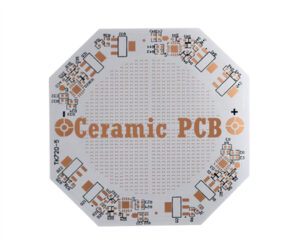Ceramic PCB
2022-09-16When we think of ceramics, we think of fancy china, and ceramic appliances fill every aspect of our lives. It is worth noting that this material due to its good heat dissipation, insulation, current-carrying capacity and a series of advantages, making it widely used in the electronics industry. The most common applications of ceramic PCB are high-power power electronic modules, aviation equipment, military electronics and other industries.
What is ceramic PCB?
Ceramic PCB is bonded together by bonding copper foil and ceramic substrate under high temperature environment. With strong bonding, copper foil will not fall off, high reliability, stable performance in high temperature and humidity environment.
With the miniaturization of equipment becoming the norm, ceramic PCBs have been a good choice in many ways. Ceramic materials such as alumina, aluminum nitride, and beryllium oxide perform well on the following parameters.
- Thermal conductivity
- Corrosion resistance
- CTE component compatibility
- High density alignment, etc.
Advantages of ceramic PCBs
Here we need to remind you that the ceramic we mentioned is not a single material, but a class of materials with similar physical and chemical properties.
- Thermal conductivity. One of the major advantages of ceramic materials is the high thermal conductivity, heat can be easily transferred to the thermal landing or active cooling components. And the high thermal conductivity also ensures that no hot spots are formed on the surface and internal circuit layers because the heat transfer is uniform.
- Low conductivity. Despite the high thermal conductivity of ceramics, the electrical conductivity is low.
- High mechanical strength. It can withstand high mechanical loads as well as strong vibrations and shocks for long-term use in harsh operating environments.
- Strong bonding force. Ceramic PCB adopts bonding technology, copper foil is not easy to fall off.
- High current carrying capacity. 100A continuous current through 1mm0.3mm thick copper body, temperature rise of about 17 ℃; 100A continuous current through 2mm0.3mm thick copper body, temperature rise of only about 5 ℃.
Disadvantages of ceramic PCB
- Fragile. This is one of the main disadvantages of ceramic PCB, which leads to the production of only a small area of the board, and requires careful handling.
- Relatively high price. Ceramic PCBs are still used in some of the higher-end products, the use is not so widespread
Applications of ceramic PCBs
- High-power power electronic modules, solar panel components, etc.
- High frequency switching power supplies, solid state relays
- Automotive electronics, aerospace, military electronics
- High-power LED lighting products
- Communication antennas, automotive ignition
Turn to KingPCB for your ceramic PCBs project!
At KingPCB, our highly qualified and experienced PCB fabricators and assemblers fabricate ceramic circuit boards, not only single-sided, double-sided, and multi-layer PCBs, and we subject them to rigorous quality control testing to ensure that you get PCBs that are built to last, regardless of material, stiffness, or other customization factors.
To learn more about how KingPCB can meet all of your PCB needs, contact us today to get a quick, free PCB quote for your business.




